
  
|
Type Specimens of Plants (National Taiwan University)
The original specimen that acts as evidence in the discovery of a new species is known as the type specimen, and should be preserved permanently. The image, label, and collection of information about the specimen, as well as the original text and pic...
More about this collection » |
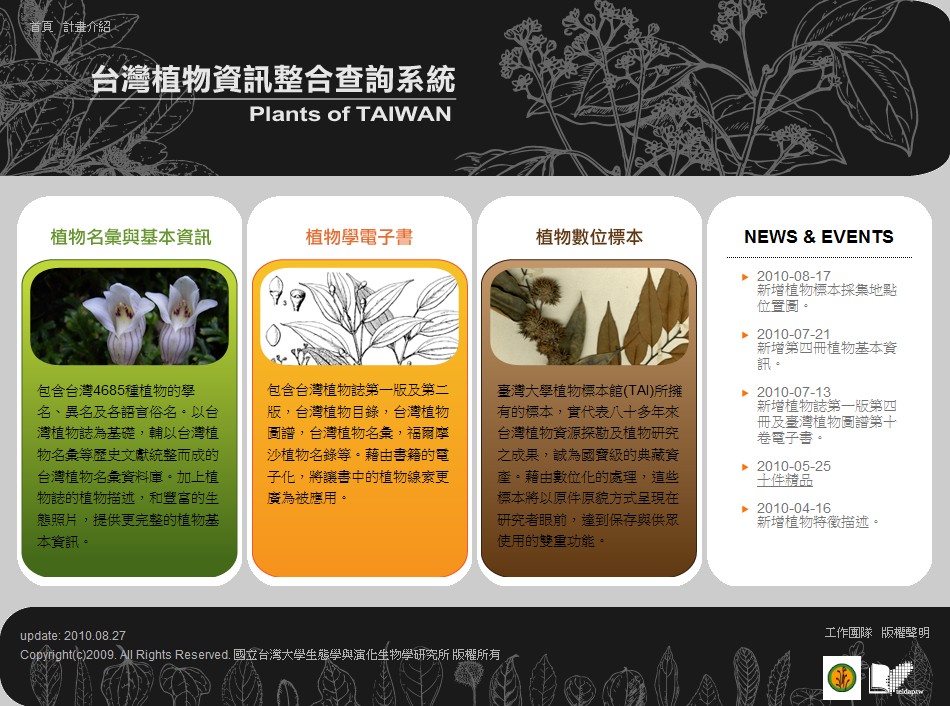
  
|
General Specimens of Plants (National Taiwan University)
Established in 1929, the Herbarium of the Institute of Ecology and Evolutionary Biology at the National Taiwan University (NTU) is now over seventy years old, with a collection of over 260,000 specimens. Among its collection, specimens of Taiwan’s ...
More about this collection » |
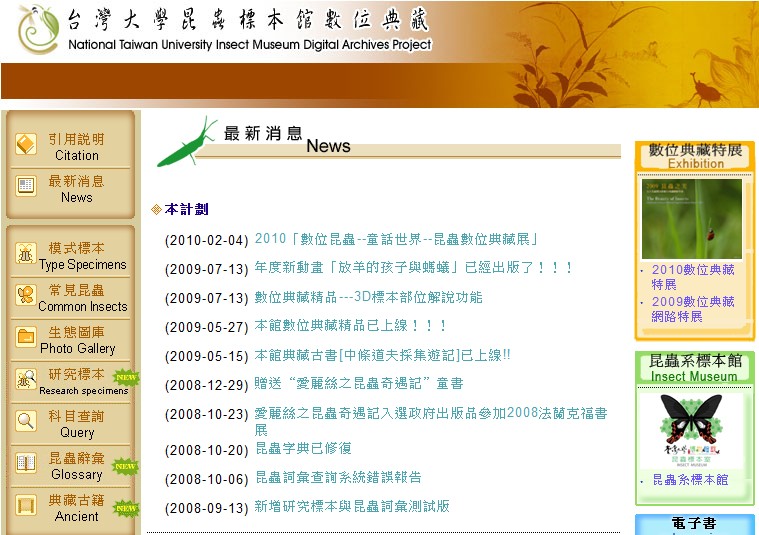

|
Type Specimens of Insects (National Taiwan University)
The Insect Museum of National Taiwan University (NTU) was founded during the Japanese Colonial Period, and holds numerous precious specimens in its collections. The NTU Insect Museum and the Agricultural Research Institute contain the two most abunda...
More about this collection » |
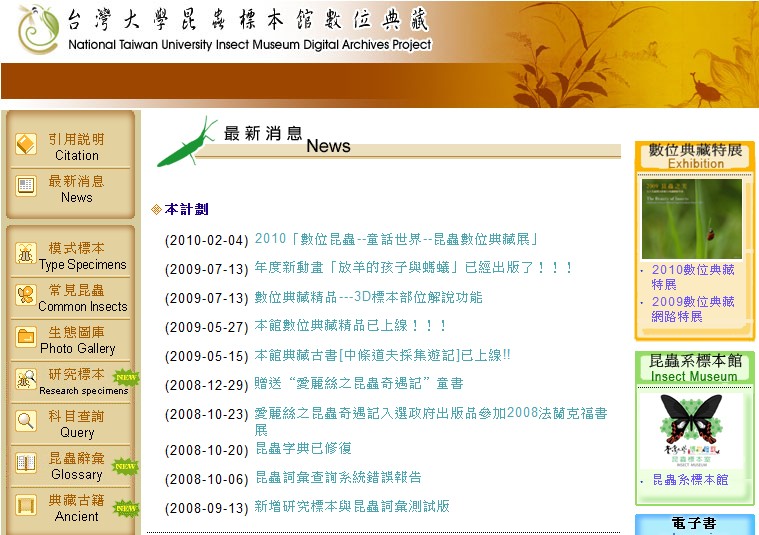
 
|
Common Insects (National Taiwan University)
The genre “Common Insects” in the Insect Museum of National Taiwan University includes specimens for research and specimens for education. Different from type specimens, these specimens are insects the general public is usually familiar with, cho...
More about this collection » |
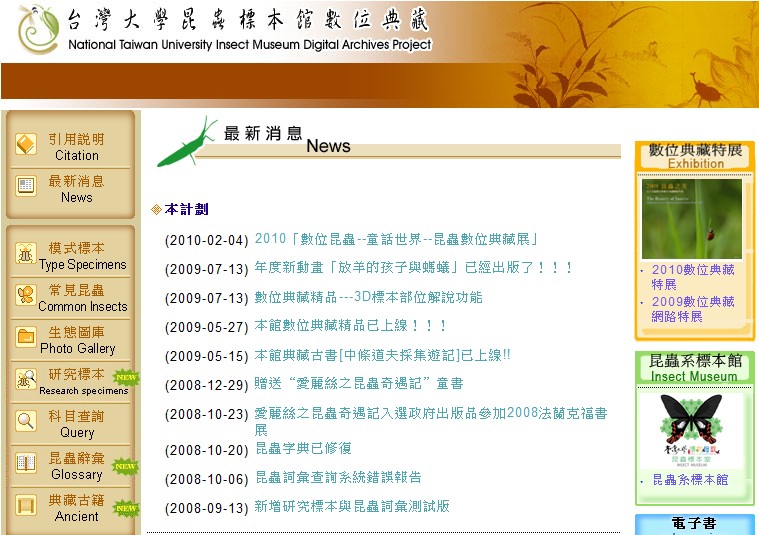
|
Gallery of Insects (National Taiwan University)
The National Taiwan University Insect Museum Digital Archives Project, aside from collecting specimen images and profiles of insect life, has also gathered photos of these insects within the ecology of their natural environments. These records give a...
More about this collection » |
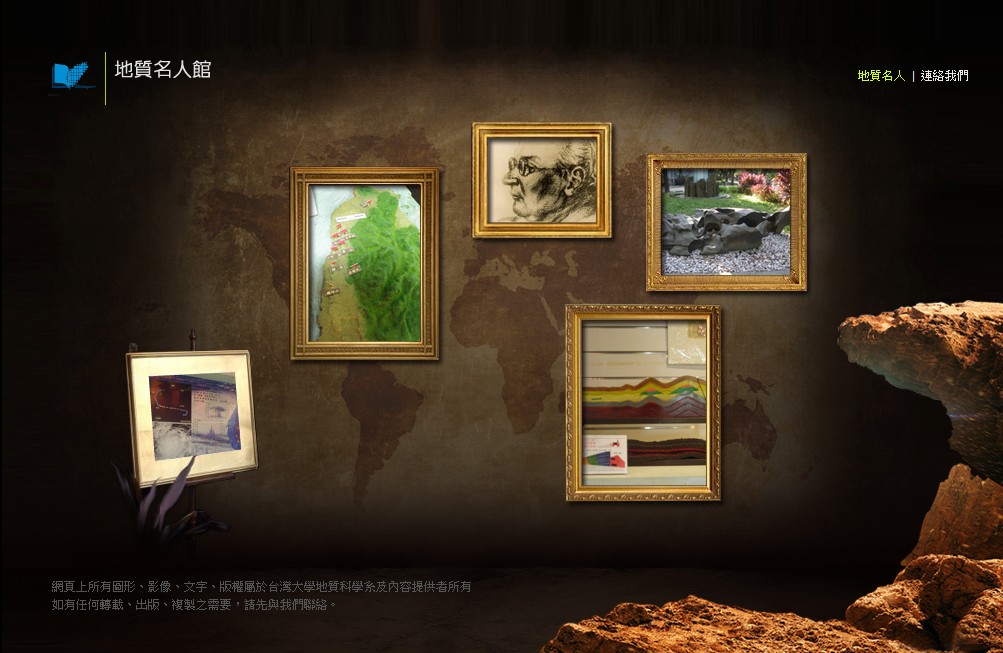
 
|
Historical Resources on Reputable Geologists (National Taiwan University)
This historical catalogue of essential scientific materials and interviews detail the development of the geosciences in Taiwan through the scientists and scholars that defined the movement. Included are both original manuscripts as well as digitized ...
More about this collection » |
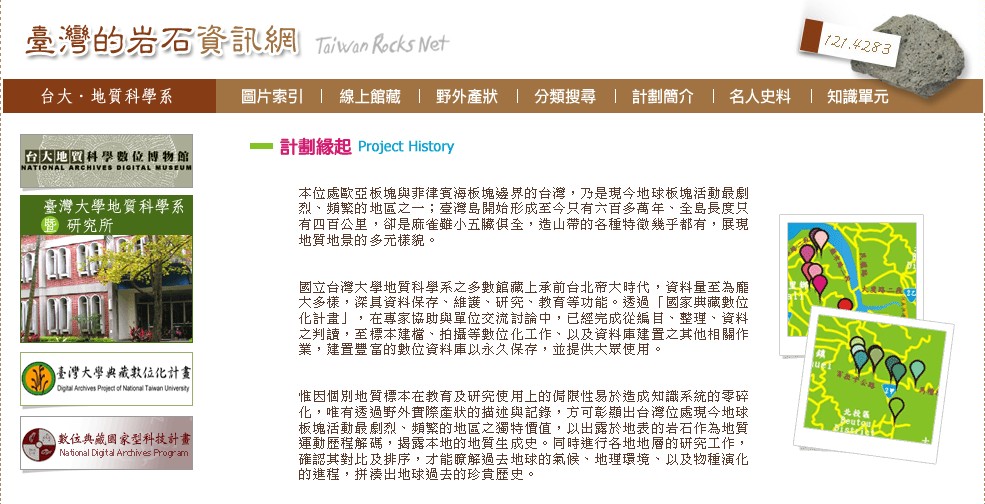

|
Natural Rock Forms (National Taiwan University)
Contained in this archive is the complete photographic record of native Taiwanese rocks found island-wide. The geographical ranges covered include the Coastal Range in Eastern Taiwan, the Central Mountain Range, the Hsuehshan Mountain Range, the west...
More about this collection » |

 
|
Ethnological Photos (National Taiwan University)
These ethnological images are field-based photos from the Taihoku Imperial University Ethnoarchaeology Seminar period and the National Taiwan University Department of Anthropology period. The main content covers not only various ethnic groups and the...
More about this collection » |
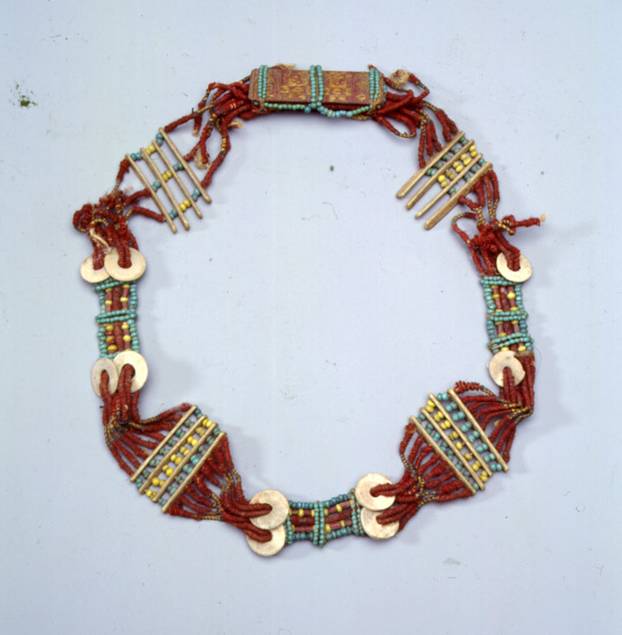
 
|
Ethnological Artifacts (National Taiwan University)
These ethnological images are field-based photos from the Taihoku Imperial University Ethnoarchaeology Seminar period and the National Taiwan University Department of Anthropology period. The main content covers not only various ethnic groups and the...
More about this collection » |

 
|
Archaeology (National Taiwan University)
This archaeological collection was founded during the period of the Taihoku Imperial University Ethnoarchaeology Seminar, and was developed and expanded with field research conducted by the National Taiwan University Department of Anthropology from 1...
More about this collection » |

 
|
Mammals (National Taiwan University)
The Mammal Database contains 8 orders, 19 families, and 67 mammal species in Taiwan. In this database, you can search and observe basic information on all of these mammal species, including their classification, morphology, natural environment, and ...
More about this collection » |

  
|
Medical Journals (National Taiwan University)
In 1895, Taiwan was ceded to Japan, and the Japanese medical education system and health care system were directly transplanted to Taiwan and influenced the establishment of the local health care system. Therefore, all the medical papers and journal ...
More about this collection » |

 
|
Medical Artifacts (National Taiwan University)
Since the beginning of the Japanese Occupation in 1895, the Japanese had built Taiwan's first hospital on Chiaki street in Da-dao-cheng– the “Japanese Taiwan Clinic,” the former name of National Taiwan University Hospital – followed by the co...
More about this collection » |

  
|
Medical Books (National Taiwan University)
In 1895, Taiwan was ceded to Japan, and the Japanese medical education system and health care system were directly transplanted to Taiwan and influenced the establishment of the local health care system. Therefore, all the medical papers and journal...
More about this collection » |

 
|
Medical Photographs (National Taiwan University)
Since 1895, when Taiwan was ceded to Japan, National Taiwan University (“NTU”) College of Medicine and National Taiwan University Hospital experienced the initial rough stages of building foundations and plan implementations. While introducing we...
More about this collection » |
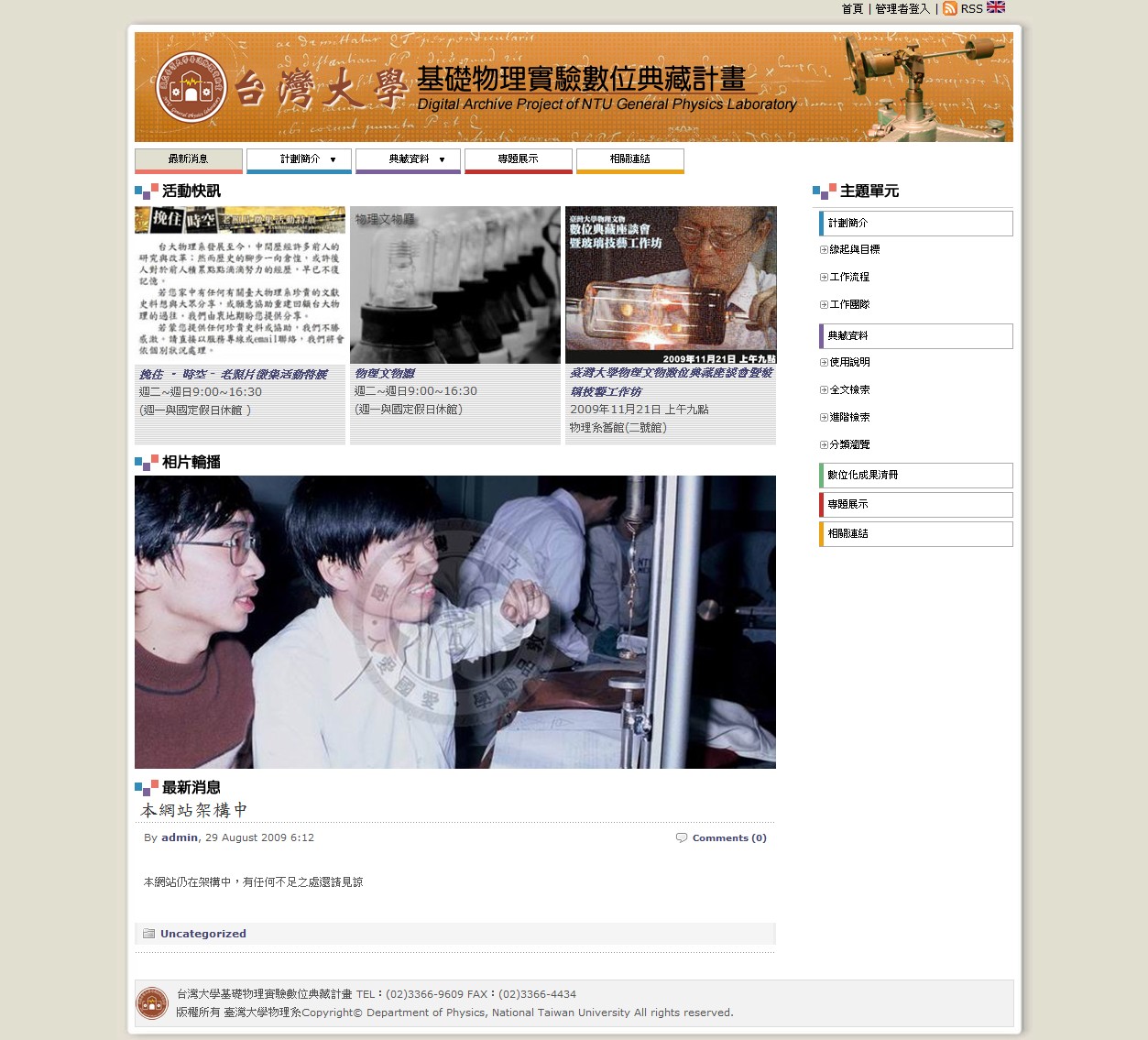
 
|
General Physics Manuscripts (National Taiwan University)
Having passed through a long history—from inheriting the hand-made or antiquated laboratory apparatuses in the age of Taihoku Imperial University and receiving an abundance of equipment during the period of U.S. aid after Taiwan’s retrocession, t...
More about this collection » |
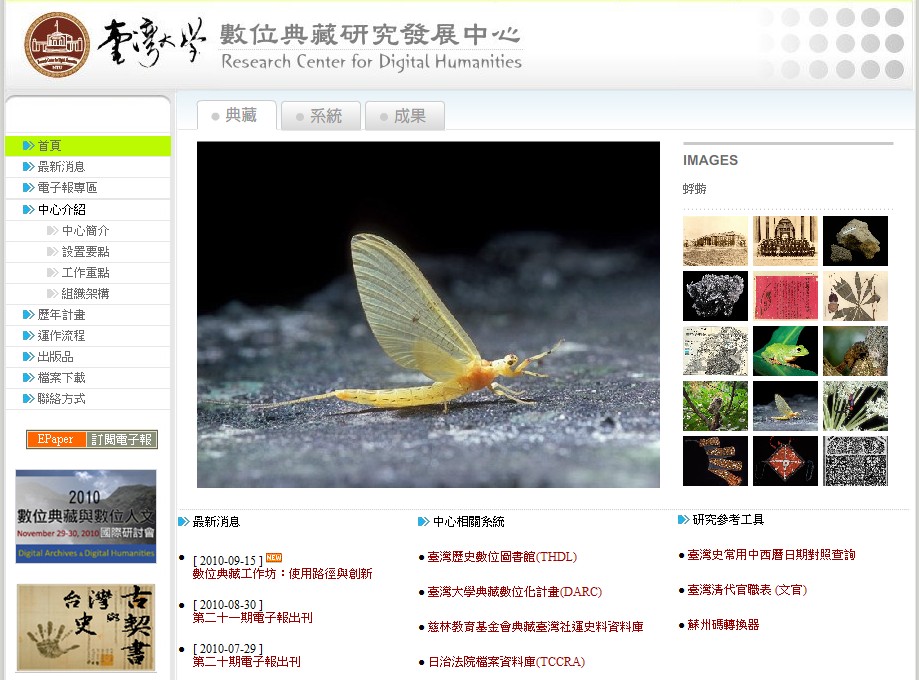
 
|
General Physics Data (National Taiwan University)
Having passed through a long history—from inheriting the hand-made or antiquated laboratory apparatuses in the age of Taihoku Imperial University and receiving an abundance of equipment during the period of U.S. aid after Taiwan’s retrocession, t...
More about this collection » |

 
|
General Physics Texts (National Taiwan University)
Having passed through a long history—from inheriting the hand-made or antiquated laboratory apparatuses in the age of Taihoku Imperial University and receiving an abundance of equipment during the period of U.S. aid after Taiwan’s retrocession, t...
More about this collection » |
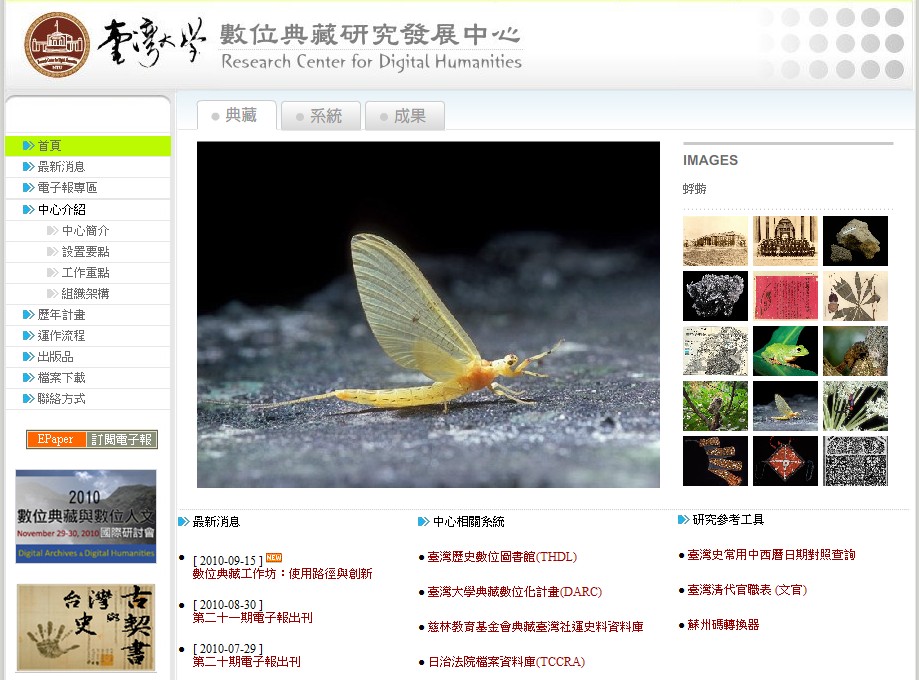
 
|
General Physics Photographs (National Taiwan University)
Having passed through a long history—from inheriting the hand-made or antiquated laboratory apparatuses in the age of Taihoku Imperial University and receiving an abundance of equipment during the period of U.S. aid after Taiwan’s retrocession, t...
More about this collection » |
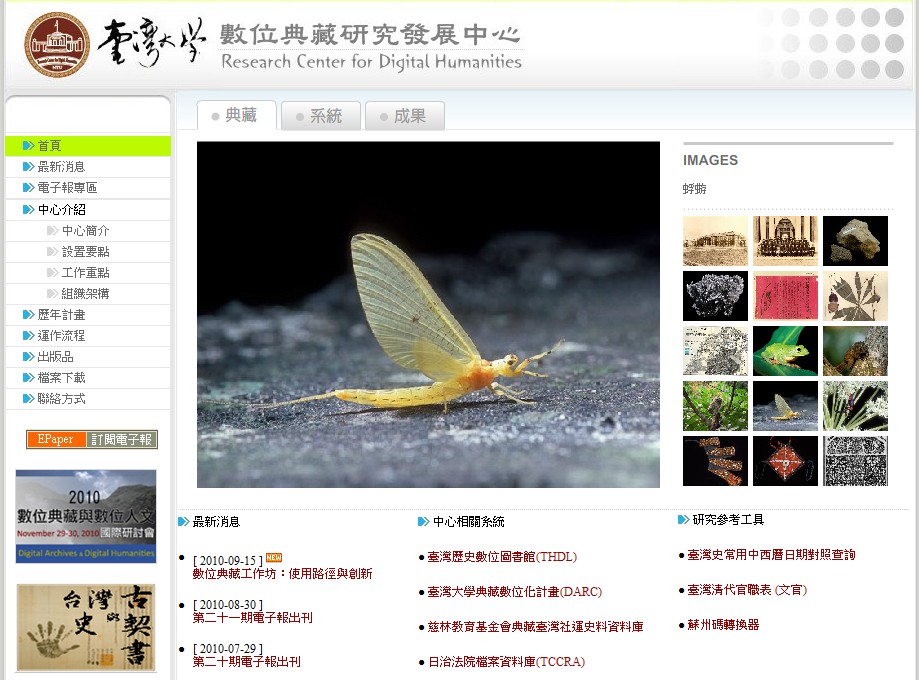
 
|
General Physics Films (National Taiwan University)
Having passed through a long history—from inheriting the hand-made or antiquated laboratory apparatuses in the age of Taihoku Imperial University and receiving an abundance of equipment during the period of U.S. aid after Taiwan’s retrocession, t...
More about this collection » |


|
The Collection of President Chiang Kai-shek (Academia Historica)
These files include documents, telegrams, diaries, letters, books, maps, audio-visual data and other artifacts of Chiang Kai-Shek's administrative legacy, compiled through the years by close aides of Chiang. During Chiang's relinquishment of power in...
More about this collection » |

  
|
The Archives of the National Resources Commission (Academia Historica)
These files span the years from 1939 to 1952, in a total of 27,985 volumes; of these, 20,074volumes are in Chinese, and 7,911 are in foreign languages. Chinese files are documents interchanged between the National Resources Commission and other subsi...
More about this collection » |
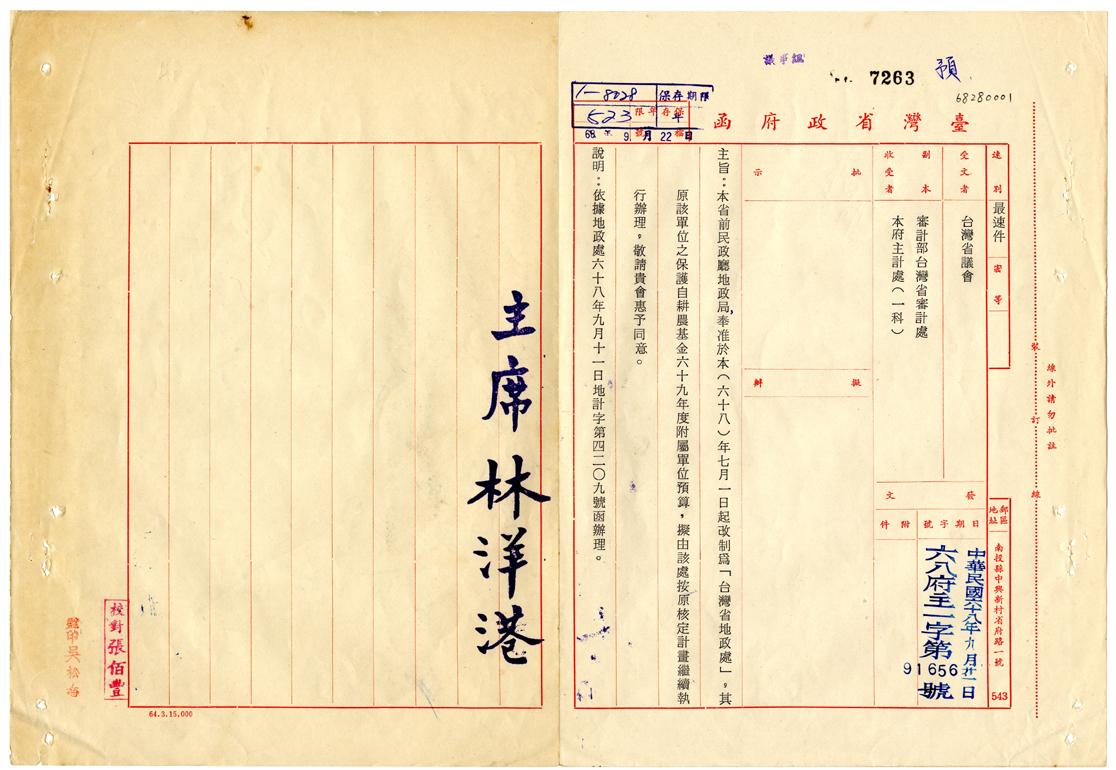

|
The Archives of the Land Administration Department of Taiwan Provincial Government (Academia Historica)
These files date from 1944 to 1992, totaling 2,151 volumes. The files can be roughly classified as follows: laws and regulations, land administration reports, conference reports, personnel organization, reception and disposal of Japanese property, la...
More about this collection » |

  
|
The Collection of President Chiang Ching-kuo (Academia Historica)
Includes 2,314 volumes of artifacts related to president Chiang Ching-Kuo, including previously classified military files, files of the Kuomingtang servicemen, records of meetings with foreign guests, acts and events, notes and speeches, photographs,...
More about this collection » |

 
|
Reptiles (National Museum of Natural Science)
There are 28 species of geckos, snakes and lizards unique to Taiwan, amounting to one-third of all native species, and holding significant evolutional and ecological importance; however, due to the destruction of ther habitats, reptiles can no longer...
More about this collection » |

 
|
Large animals (National Museum of Natural Science)
Specimens of birds and beasts in the collection of the Museum of Natural Science include mainly stick-shaped fur study specimens, loose bone study specimens, and soaked specimens preserved in ethyl alcohol. Collection of specimens focuses on wildlife...
More about this collection » |

 
|
Amphibians (National Museum of Natural Science)
Amphibians are the only vertebrates with a two-staged lifestyle. They have a special relationship with other animals in between land and water, and play an important part in the ecosystem. They are mostly small in size and nocturnal. Of the known nat...
More about this collection » |

 
|
Birds (National Museum of Natural History)
This project aims to establish a database of local bird specimens, and become a stronghold of avian studies in Taiwan. Current specimens span 18 orders, 70 families and 369 species, with a total of approximately 5,000 specimens; the systematic collec...
More about this collection » |


|
Whales and dolphins (National Museum of Natural Science)
The survey and study of whales and dolphins in Taiwan only began in 1990; with the advent of marine surveys and whale watching, visual and academical information of wild whales and dolphins in regional waters has also accumulated. The Museum of Natur...
More about this collection » |

 
|
Fishes (National Museum of Natural Science)
Starting from 2003, the Museum of Natural Science has systematically collected fish specimens. Current goals focus on Taiwan-specific freshwater fish. Collaboration with other academic organizations is also under way, improving the speed and variety ...
More about this collection » |

 
|
Insects (National Museum of Natural Science)
The current goal of the insect department is the collection of insect and mite specimens of Taiwan, aiming to expand to those from the Asian Pacific region and the entire world. The orders Lepidoptera and Homoptera are the main focus, with specimens ...
More about this collection » |


|
Echinodermata(National Museum of Natural Science)
Echinoderms are a group of large invertebrate animals that live completely in the sea. They are distributed from the intertidal zone to several thousand meters deep in the ocean. However, people come into contact with echinoderms most commonly on din...
More about this collection » |
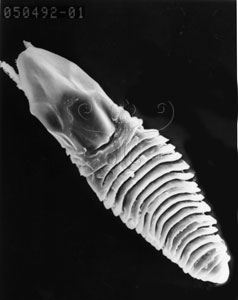
 
|
Eriophyoidea (National Museum of Natural Science)
Insects of the Eriophyoidea superfamily are mites smaller than the naked eye can see, around 0.1~0.3 mm in size and worm shaped. Currently the Museum of Natural Science has in its collection around 7,000 Eriophyoidea slide specimens, including more t...
More about this collection » |
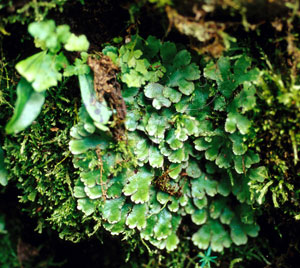

|
Moss (National Museum of Natural Science)
Moss, to the average person, is a common yet alien group of plants. Compared with flowering seed plants and non-flowering ferns, the composition of bryophytes is relatively primitive and simple, without vascular transmission tissues. Transmitting fun...
More about this collection » |

 
|
Fungi (National Museum of Natural Science)
Fungi are the second largest biological group after insects. Not only is there a large number of fungi types, their distribution is very widespread on the planet, and can be found in the air, on land, below the ground, in water, and on or inside othe...
More about this collection » |

 
|
Fungus type specimens (National Museum of Natural Science)
There are over 15,000 fungus specimens in the collection of the Museum of Natural Science, making it the largest collection of fungus specimens in Taiwan. The Museum houses 70 type specimens of fungi, and has also included data of type specimens in o...
More about this collection » |

 
|
Lichens (National Museum of Natural Science)
Life exists everywhere, in all corners of nature. Even on the rocks or branches of the cold mountain plains, yellow, gray, white, brown or orange patches, and hanging or crawling stem-like and leaf-like forms can be seen. These are all complicated li...
More about this collection » |
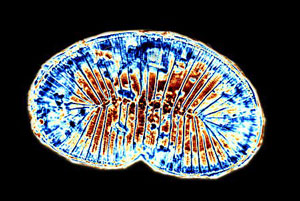
 
|
Diatoms (National Museum of Natural Science)
Digitized specimens and the introduction of diatom knowledge are both included here. Two main focuses are provided in the introduction: (1) the summary of diatom habitats and of frustule forms; (2) frustule types. Our specimens can be divided into tw...
More about this collection » |
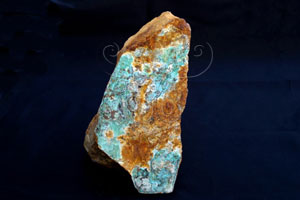
 
|
Minerals (National Museum of Natural Science)
Mineral specimens form an important part of the geology collection of the Museum of Natural Science; specimens include more than a thousand items from around 200 types of minerals. A large variety of regional minerals are represented, as are many pre...
More about this collection » |
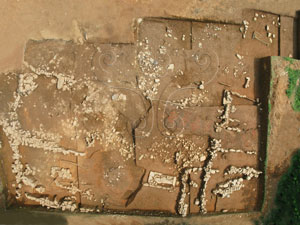

|
Archaeological collections from central Taiwan (National Museum of Natural History)
Scholars of prehistoric Taiwan have devided archaeological culture of the west coast into north, central and south. Of these divisions, archaeological collections from central Taiwan include the prehistoric Dapenkeng, Niumatou, Yingpu, Damalin, Fantz...
More about this collection » |


|
Archives of the Office of the Chief Executive (Taiwan Historica)
The Office of the Taiwan Chief Executive was the special governmental organization set up by the National Government in the early years after World war II, and was mainly occupied with property expropriation and rebuilding affairs. The files of the O...
More about this collection » |


|
Digital archives of fish fauna from Taiwan (Academia Sinica)
The fishes of Taiwan, over 10% of the world’s fish, comprise 2,902 species in 292 families so far and their taxonomic and distributional data have been integrated into a database that can be accessed interactively through internet at http://fishdb....
More about this collection » |
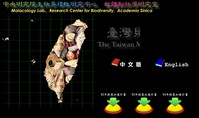
 
|
The Taiwan Malacofauna Database (Academia Sinica)
The Taiwan Malacofauna Database includes the following sub-database: 1. The Catalogue database-Basic information with photos of each species. 2. The Distribution database-Through the web-site, users can learn the shell distribution in Taiwan area. 3....
More about this collection » |
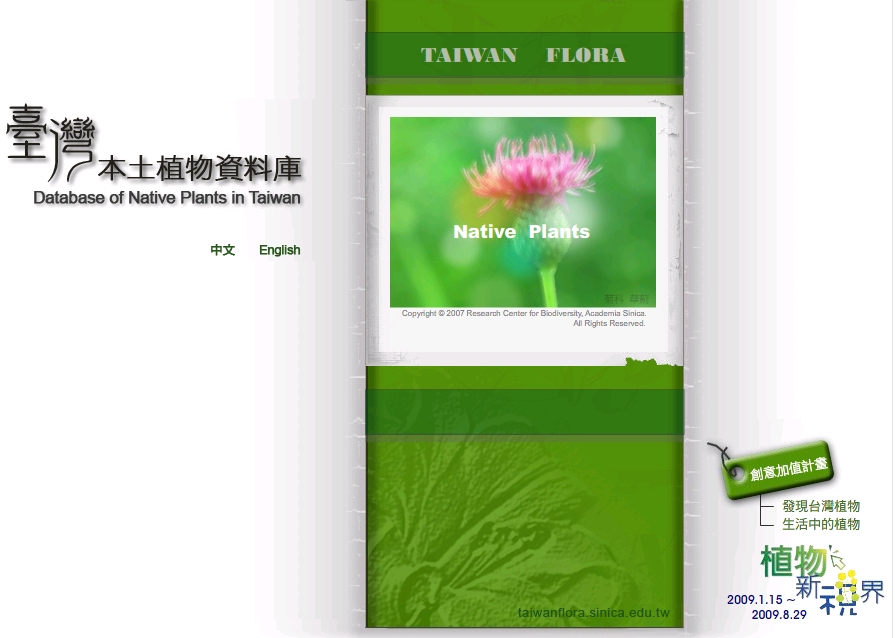
 
|
Literatures of Native Plants in Taiwan (Academia Sinica)
Literature Database of Native Plants in Taiwan consists mainly of the classified literature on Taiwan vascular plants. The intent is to build a classified catalogue and data system of native Taiwan plants and to present data of different periods and ...
More about this collection » |
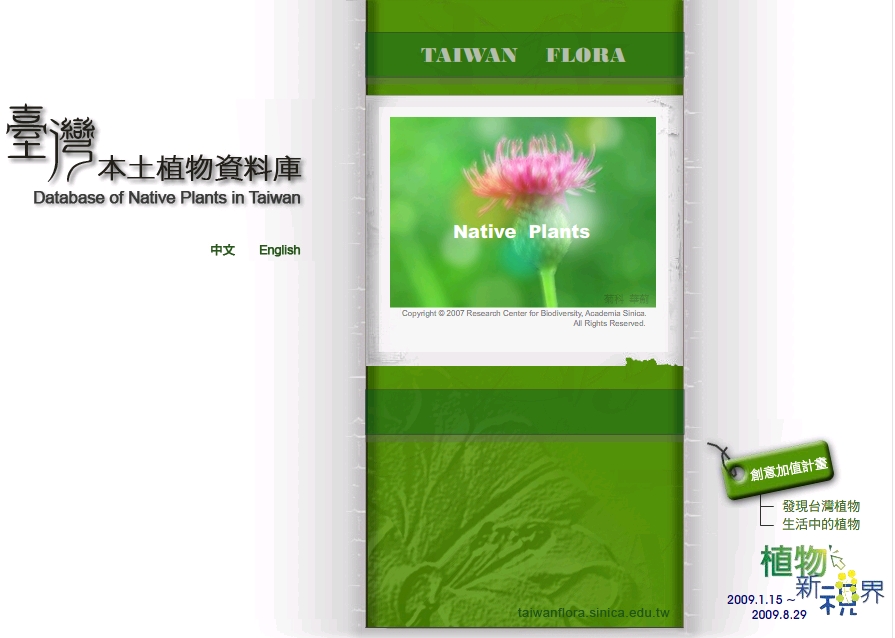
 
|
Specimens of Native Plants in Taiwan (Academia Sinica)
There are over 115,000 specimen items in the Herbarium of Academia Sinica, among which approximately 85,000 were gathered locally in Taiwan. The intent is to build a Chinese-English bilingual search system of native Taiwan plant specimens that compri...
More about this collection » |
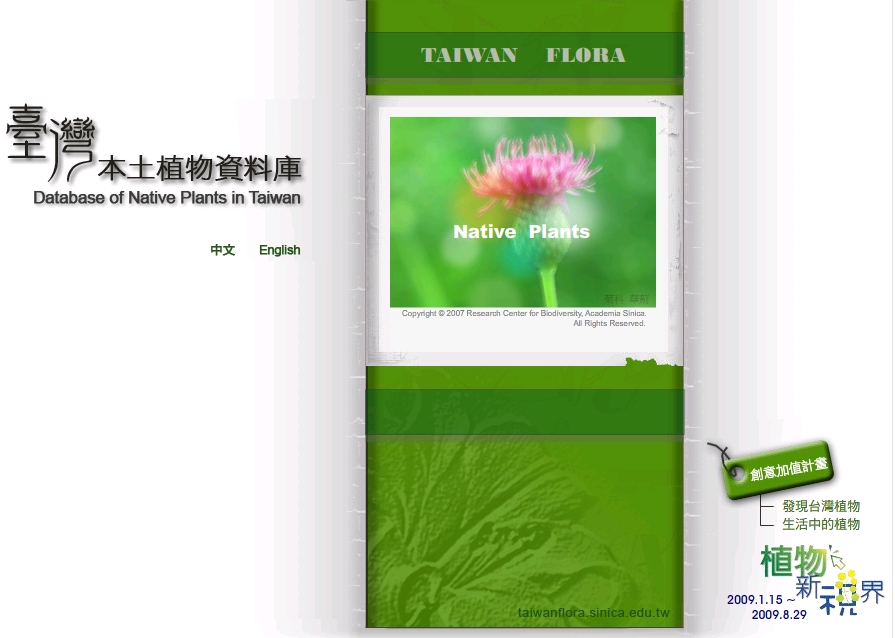
 
|
Images of Native Plants in Taiwan (Academia Sinica)
The image database of native plants in Taiwan consists mainly of the wildlife photos of Taiwan vascular plants. Preserving valuable image files, the database documents the precious natural resources of Taiwan, and provides a great basis for expert ac...
More about this collection » |


|
Academia Sinica Tagged Corpus of Early Mandarin Chinese (Academia Sinica)
The Academia Sinica Tagged Corpus of Early Mandarin Chinese is designed for historical linguistic research. The corpus contains texts in Early Mandarin Chinese (from Tang to Qing) that are selected because of their usefulness in grammatical and lexic...
More about this collection » |
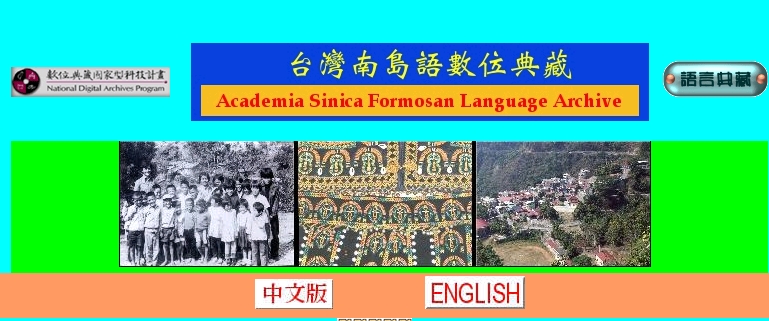
 
|
Formosan Language Archive (Academia Sinica)
This archive project aims to record and maintain these languages through collecting and/or editing existing texts in digital forms with corresponding audio files. The Formosan Language Archive includes both Chinese and English browsing display on the...
More about this collection » |

 
|
Mandarin Topic-oriented Conversation Corpus (Academia Sinica)
The Mandarin Topic-oriented Conversation Corpus (MTCC) was recorded in 2002, from January to March. The conversations are natural discussion between two familiar persons. The topic of the conversations is on one chosen event happened in 2001. There a...
More about this collection » |

 
|
Southern-Min Archive: A Database of Historical Change in Language Distribution (Academia Sinica)
The Southern-Min Archive: A Database of Historical Change in Language Distribution" project is a new addition in 2003. It aims to provide both a historical depth and sociological variation to the archives of Chinese languages in Taiwan."...
More about this collection » |
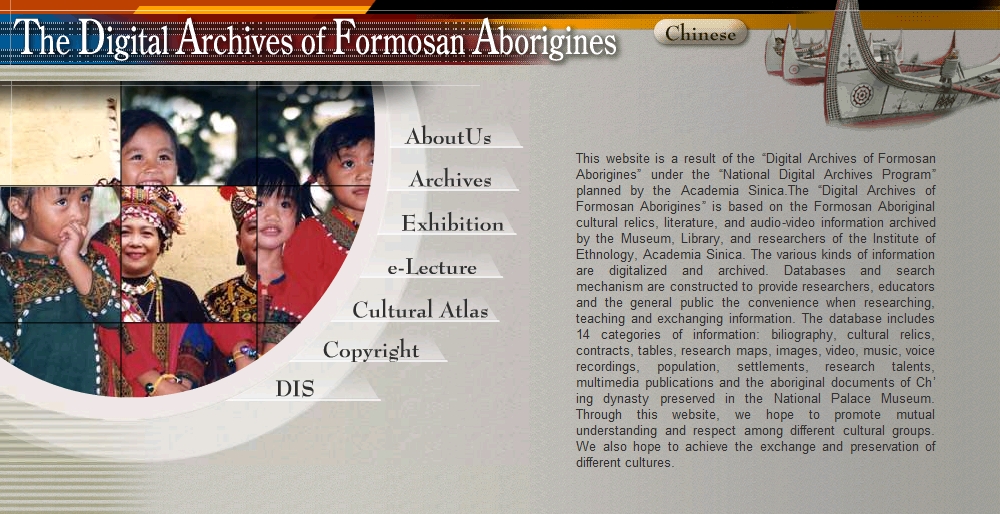
 
|
The Digital Archives of Formosan Aborigines (Academia Sinica)
The foremost target of the “The Digital Archives of Formosan Aborigines” is to sustain the aboriginal research information archived in the Institute of Ethnology of the Academia Sinica for the educators, academics, and the general public. The dat...
More about this collection » |
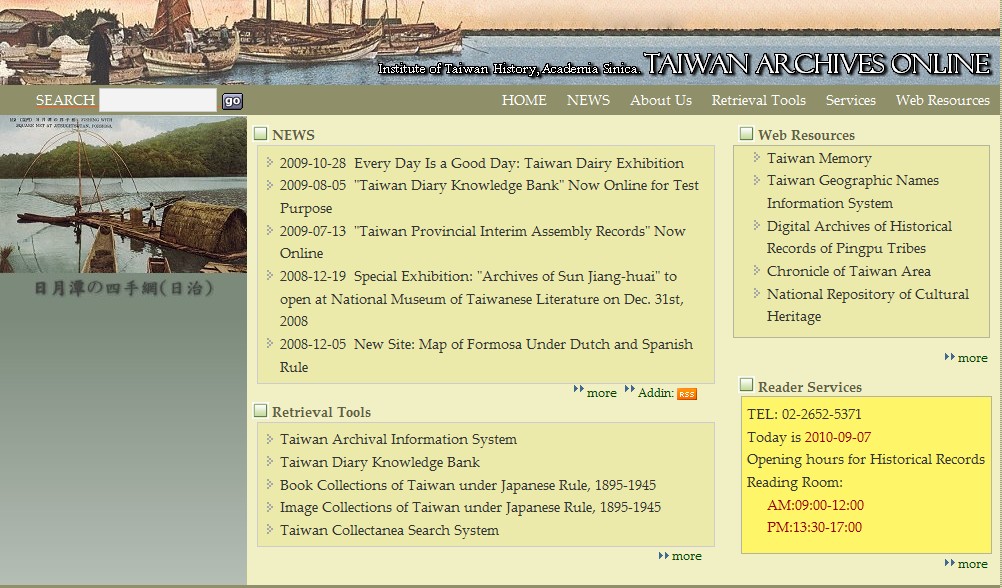

|
Taiwan Collectanea (Academia Sinica)
“Taiwan Collectanea” was the biggest compiling in Taiwan’s related literature, which was published by Taiwan Bank’s economic research room in 1957 to 1972. Since it had published, it had become the material used and cited with highest frequen...
More about this collection » |
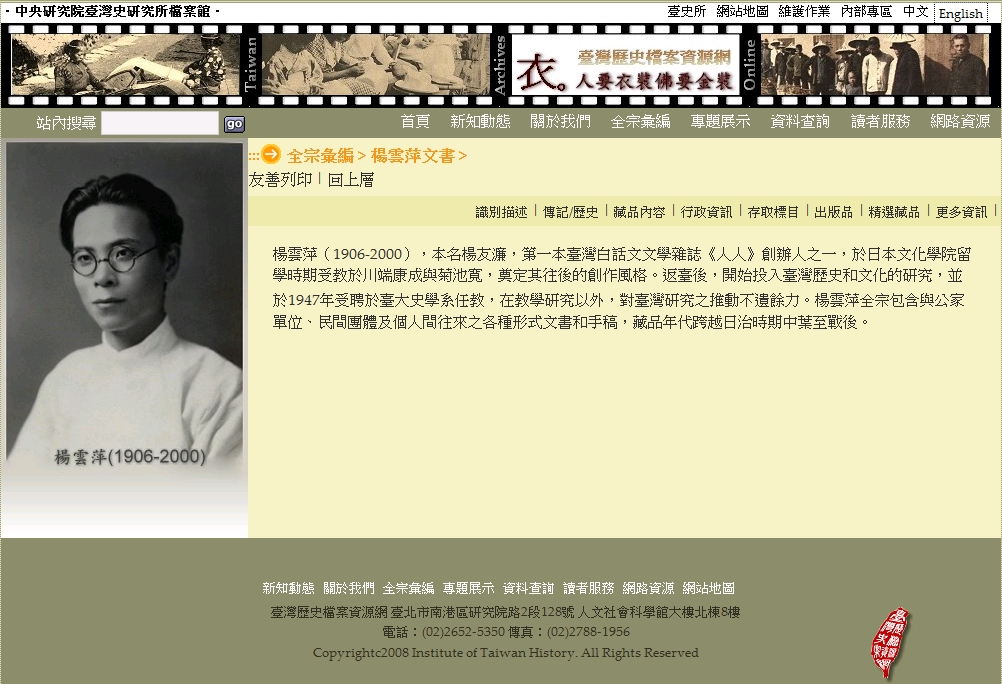

|
The Yang Yun-Ping Collection (Academia Sinica)
Yang Yun-Ping (1906-2000) is previously known as Yang You-Lian. He published an article on The Taiwan Minpao with the pseudonym “Shih-Lin Yun-Ping Sheng” in 1924, after that he was known as Yun-Ping generally. In 1925, he published “Renren” m...
More about this collection » |


|
Historical Records (Academia Sinica)
The database includes civil contracts and commercial data collected by Institute of Taiwan History. Civil contracts embrace contracts of paddies/real estate business, loan/mortgage, and division of family property, license, and personal relationship ...
More about this collection » |
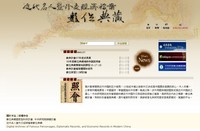
 
|
Diplomatic and Economic Archives (Academia Sinica)
The Institute of Modern History, Academia Sinica, has kept a collection of files on foreign and economic offices and data donated by individuals. The files on foreign offices include documents from the Office in Charge of Foreign Affairs (1861-1901),...
More about this collection » |


|
Weaving (National Museum of History)
Since 1959, the National Museum of History has acquired the woven fabrics either through donations or purchases, which are mostly the clothing from the Qing dynasty and the early Republic of China, bringing the weaving collection to the total of over...
More about this collection » |
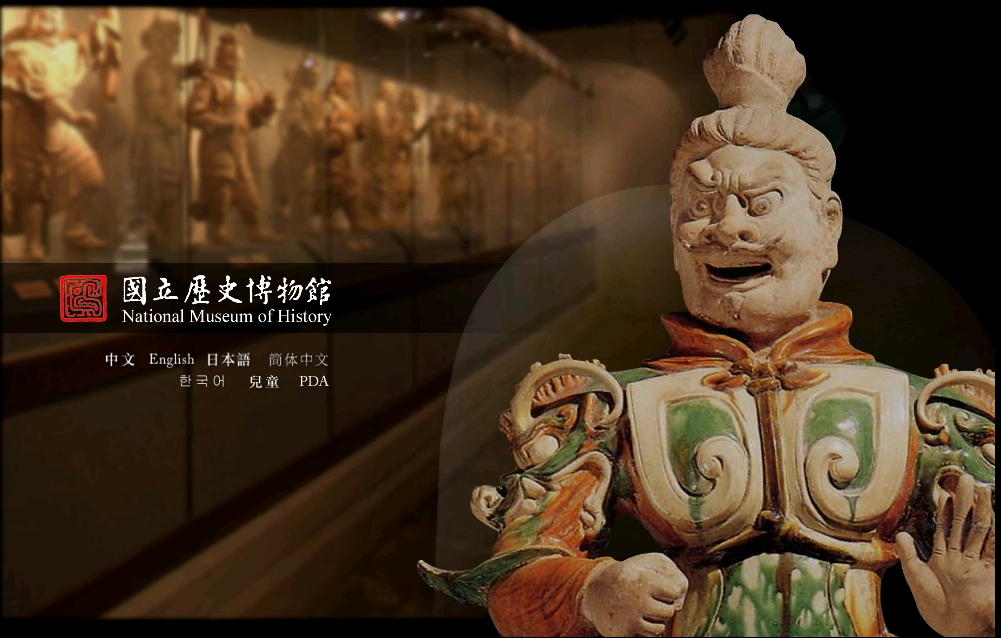

|
Glassware (National Museum of History)
The National Museum of History has collected glassware since 1996 and housed 213 pieces currently. The collection comprises utensils of daily use, burial objects and decorative pieces; their styles imitate those of jade, porcelain (or bronze ware), a...
More about this collection » |


|
Enamel (National Museum of History)
Since 1956, enamel artifacts has been added to by the National Museum of History and reached a total of 182 items so far. Enamel pieces can be divided into several types such as utensils of daily use (bowls, cups, plates), decorative objects (snuff b...
More about this collection » |
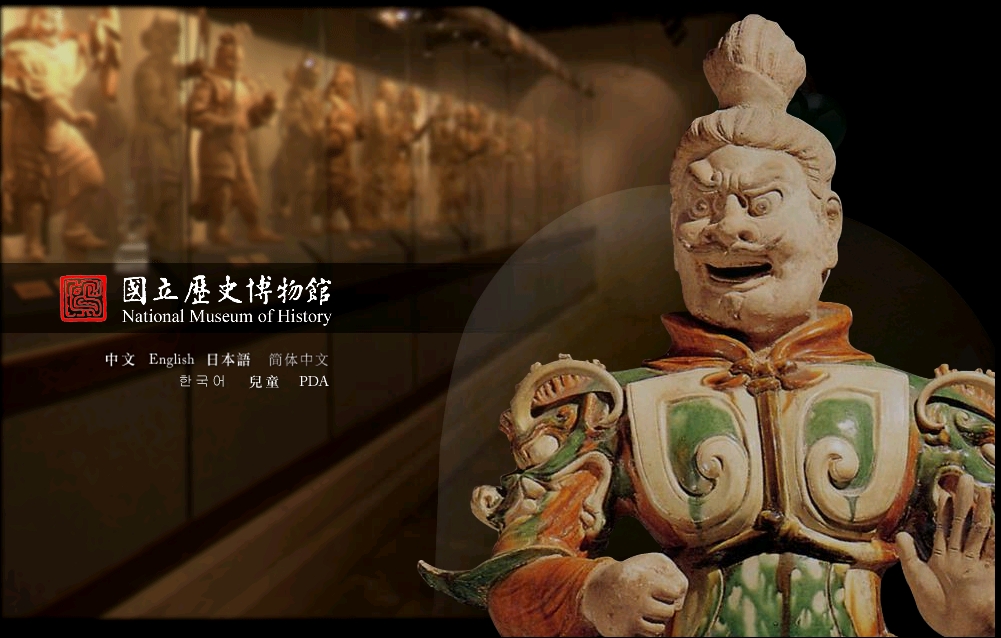

|
Photography (National Museum of History)
Beginning 1976, the National Museum of History has accumulated photographic works, bringing up to 398 pieces in 2000. Though the technology used in photography has undergone several changes since its birth, the collection here is still that of tradit...
More about this collection » |





